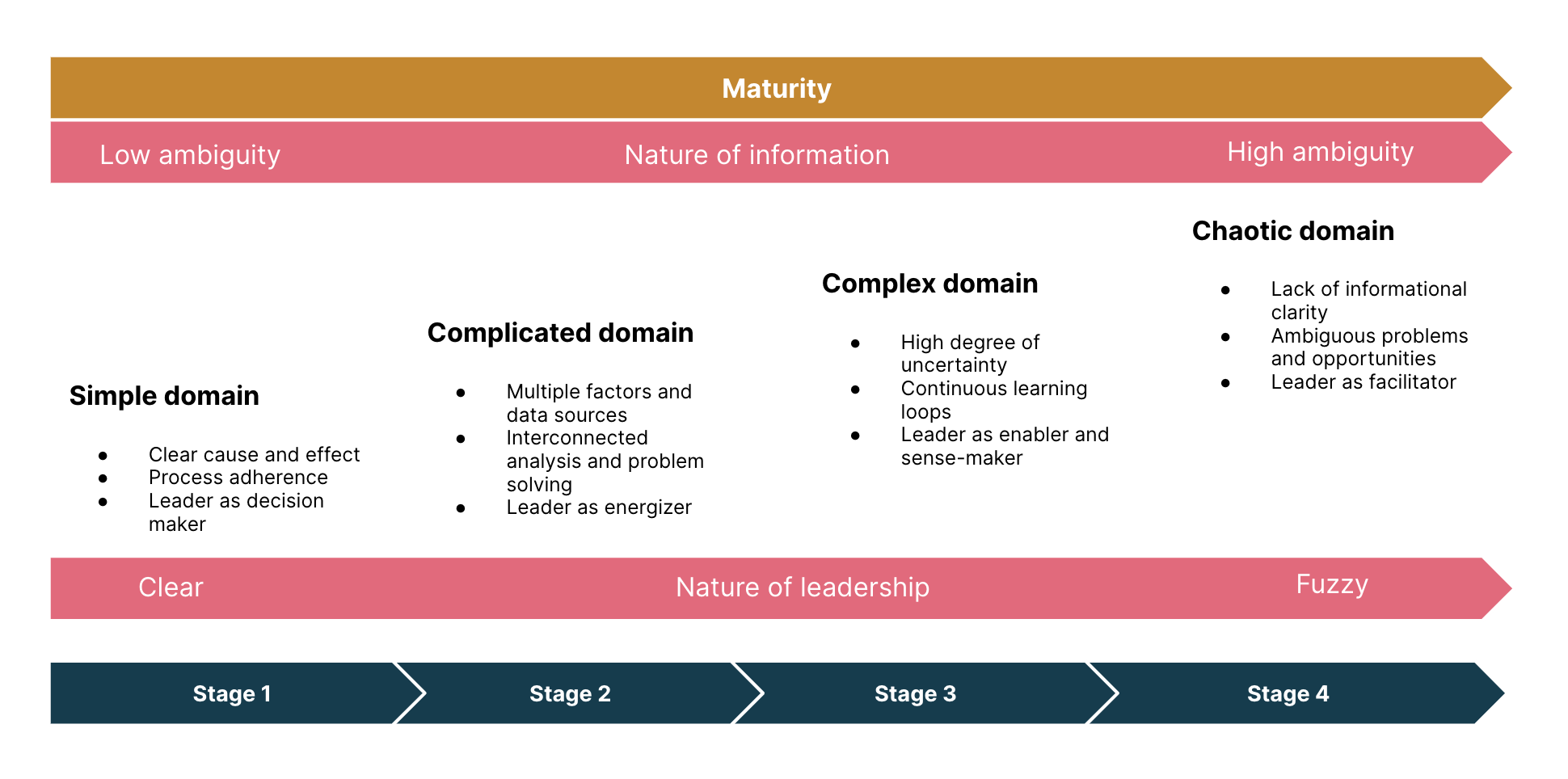The only certainty in today’s world is uncertainty. To be effective in this environment, leaders need the right set of skills, approaches and tools. In this blog, we draw from Dave Snowden's Cynefin framework to identify leadership approaches that can be used to navigate complexities in digital work. Dave previously worked for IBM where he was a Director of the Institution for Knowledge Management and founded the Cynefin Centre for Organizational Complexity
The Cynefin framework outlines four main domains of complexity: simple, complicated, complex and chaotic. The characteristics of each of these are described in the figure below.


Figure 1: Domains of complexity according to the Cynefin framework
These domains need not be mutually exclusive or sequential. For instance, in any organization, a leader could be facing a complicated domain in one project/team and chaotic in another. Therefore, to succeed in the digital world, leaders need to be agile, adaptable and comfortable wearing different hats. Some of the key traits that enable this are as follows.
‘Perfection’ to ‘pivot’
As the environment and technology evolve, a leader must learn to pivot. This requires a high level of flexibility, spontaneity and the ability to deliver despite the fuzzy definition of ‘perfect’. As things get chaotic, here are a couple of questions that can help guide a leader’s thinking:
How often do you adapt to internal realities and external shifts?
If the definition of perfect is itself imperfect, then how often do you learn from each version of your work to move closer to perfection?
From ‘me’ to ‘we’
Digital work requires effective collaboration. Therefore, a leader should have the capability to bring people together and create a sense of shared purpose. They must facilitate value creation in teams and then ensure that value flows seamlessly from one team to another.
From ‘dictating’ to ‘guiding’
As distributed, hybrid modes of work become more common, digital workplaces present new challenges for leaders — an important one being communication. A leader in this world needs to communicate effectively, articulate goals and expectations, and understand the perspectives of others.
To be successful, a leader must know to listen. They must listen carefully and empathetically so that everyone on the team feels safe and welcome to contribute. As situations evolve, a leader’s listening skills will be fundamental to deriving answers to challenging questions in partnership with their teams.
Staying true to your North Star
A leader must, primarily, have a clear vision for the future. Armed with this vision, they should inspire and motivate their teams to achieve that vision. While the vision is an organization’s unshakeable true North Star, its attainment is an exercise in iterations. The iterations could be of people strategy to figure out how best to build a digital workforce; of tools to stay cutting edge and more.
Responsible experimentation
Digital work often involves taking risks. Leaders need to create a culture that supports and encourages risk-taking. In practice, this means running experiments in a controlled environment, with an eye towards creating value. This value could be intrinsic (leading to a learning loop, dramatically increasing the pace at which a team iterates and builds features) or extrinsic (an experiment that results in a feature that directly impacts the customer).
Riding the paradox
Uncertainty and ambiguity regularly challenge digital leaders to make choices that don’t fit into black and white categories. This can mean making big trade-offs and choosing what makes the most sense within the current context. One of the most common conundrums leaders are likely to face is adaptability versus predictability. Here are two examples:
How to deliver experiences to end-customers predictably, while still pivoting and adapting my digital assets in response to ever-changing consumer needs/competitive landscape?
How to build a steady inflow of predictable digital talent while ensuring that this talent flexes and is adaptable to the needs of tomorrow?
More than ever before, leadership in today’s digital world is about organizing and encouraging teams in the context of a future which often seems in rapid flux. The disruptions that cause the uncertainty could be external (such as the labor market, geo-political conflicts, and shifting consumer expectations) or internal (such as culture erosion, digital talent demands for continuous learning and talent turnover). Either way, a leader must remain unfazed in the face of uncertainty, adapt to evolving situations and inspire their teams to follow them.
While technical skills and performance can get someone to a leadership position, it is the behaviors and decisions of leaders that make them successful in their new role. The approaches above present a starting point for thinking about what it means to be a successful leader today.
Disclaimer: The statements and opinions expressed in this article are those of the author(s) and do not necessarily reflect the positions of Thoughtworks.


















